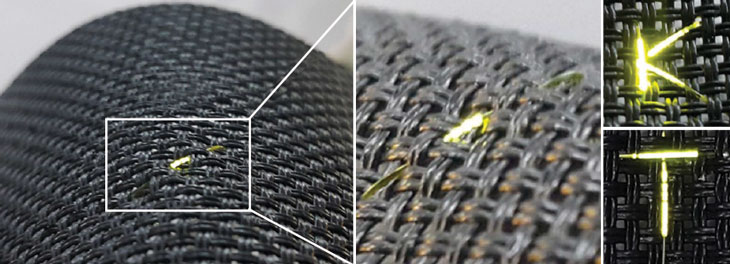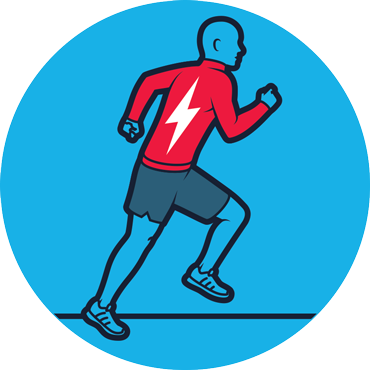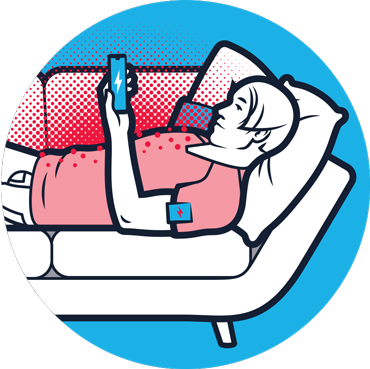Future smart clothes could pack serious gadgetry-2
Whether consumers will buy in is another story
4. Add light to your life
Light-up clothes of the future will look and feel less like your uncle’s ugly Christmas sweater and more like the sleek suits in the movieTron: Legacy.
Actress Claire Danes lit up the 2016 Met Gala in a gown laced with LEDs. But standard, semiconductor-based LEDs are too stiff and brittle to make comfortable daywear, says Seonil Kwon, an engineer at the Korea Advanced Institute of Science and Technology in Daejeon, South Korea. Organic LEDs, or OLEDs, on the other hand, are razor-thin and superpliable.
An OLED display contains a layer cake of organic, or carbon-based, material films. The OLED lights up when a power source — like a battery — drives electric charge from one layer of organic material to another, where negative electrons pop into positive holes in the material. Whenever a positive hole and negative electron pair off, they release a brief flash of light. Many positive-negative meetups per second keep the OLED lit.

OLEDs are typically built on panes of plastic or glass, but Kwon and colleagues have created OLEDs on fabric. The researchers lay these OLEDs, just 200 nanometers thick, atop a polyester film that’s laminated onto fabric made of tightly woven, superfine polyester fibers. The setup is more flexible than the plastic platforms used to make bendy displays.
The new fabric-based OLEDsare bright enough to rival current display technology, Kwon and colleagues reported last July inScientific Reports.Each OLED emits only a single color, but engineers could make fabric-based screens with many color-changing OLED pixels to display messages. Kwon’s group made OLED threads too, for lettering and patterns, reporting the work in the Jan. 10Nano Letters.

Are there consumers who find the act of pulling a phone from their pocket so burdensome that they want to tote a smartphone screen on their sleeve? Who knows. But clothes sporting single-color OLEDs could light up pedestrians and bikers at night. Kwon also imagines creating OLED garments that glow white to provide light therapy. Some people who suffer fromseasonal affective disorder find relief by sitting near a special lamp called a light therapy box, which gives off white light to mimic outdoor sunlight (SN: 4/23/05, p. 261). A shirt or underside of a hat brim that glows white could offer light therapy that goes where you go.
 JAMES PROVOST5. Power up with sun and your moves
JAMES PROVOST5. Power up with sun and your moves

After a full day’s work, “no one wants to have to take off their shirt and plug it in,” says Rajan Kumar, a nanoengineer at the University of California, San Diego. Long battery life in smart clothing is key. So why not design wearables that continuously convert sunshine and motion energy into electricity?
Researchersdebuted this kind of energy-harvesting fabricin 2016 inNature Energy. Primarily made of synthetic polymers and wool fibers, the fabric is lightweight, flexible and breathable. A 4-by-5-centimeter piece worn for a run in the sun can charge up a cell phone, says Stanford University materials scientist and engineer Jun Chen, who did the work in the lab of Zhong Lin Wang at Georgia Tech.
The sunlight-catching patches of fabric are threaded with photovoltaic wires. When sunshine strikes a wire, light particles knock electrons out of atoms in one layer of material, leaving behind positively charged holes. Another electron-conducting layer of the wire collects those loose electrons, while a third layer gathers up the positively charged holes. That charge separation creates a voltage to produce electricity that can power devices.
Meanwhile, other patches of this fabric transform the energy of motion into electricity. These swatches contain strips of a polymer called PTFE — which hoards electrons — interlaced with copper wires — which easily give up electrons. Whenever the fabric is folded or compressed, some of the copper wires’ electrons rub off on the PTFE strips.
This process builds up static charge, just like combing your hair or peeling off a sweater in the winter. When the fabric relaxes, the negatively charged PTFE strips separate from the positive copper wires, creating voltage to power devices. Strips of this material could be sewn into sleeves to generate energy from the swing of your arms, or into the soles of shoes to get energy from footsteps, says Georgia Tech’s Wang, a materials scientist and engineer.
The energy this fabric gathers up when you’re moving around or sitting in the sun could also bestored in a capacitor or battery attached to the garment(SN: 11/26/16, p. 5). The storage device might be made of ink containing zinc-silver oxide printed directly onto clothing, as described in 2017 inAdvanced Energy Materials. Or perhapsthe energy could be stored in zinc-ion yarn batteries, like ones reported in the April 24ACS Nano.
This energy-harvesting material could also be built into tents that, when bathed in sun or rustled by wind, could charge campers’ devices.
 JAMES PROVOST6. You as a walking generator
JAMES PROVOST6. You as a walking generator

If clothing were packed with thermoelectric generators, body heat could be turned into electricity.
Researchers at North Carolina State University in Raleigh work with a button-sized generator containing a grid of semiconductor rods sandwiched between two ceramic plates. When one side of the generator is hotter than the other — say, when that side is close to your skin while the other is exposed to air — electrons at the warm end of each semiconductor rod get jittery. These electrons diffuse toward the cold side of the device, creating a tiny voltage across the rod. Connecting the positive end of each rod to the negative end of the next adds up these voltages like stacking batteries in a flashlight.
Daryoosh Vashaee, an electrical engineer at NC State, and colleagues embedded these thermoelectric generators in a T-shirt. If someone wearing the shirt is just sitting around, the generator doesn’t produce much power because the temperature difference between skin and the surrounding air is so small. But if that person gets up and walks or jogs, a boost in body temperature will heat the side of the generator inside the T-shirt, while wind cools the exposed side of the generator. In one test, the generatorspumped out six microwatts of power per square centimeterwhen the wearer was walking and 18 μW/cm2during jogging, the researchers reported in 2016 inApplied Energy.
Unfortunately, that’s nowhere near enough to power a smartwatch or a phone. But generators a couple centimeters across could feed low-power sensors like heart monitors. And researchers are trying to boost the generators’ efficiency to support more power-hungry electronics. If researchers can make thermoelectric generators better powerhouses even when a wearer is seated, this tech would have one advantage over sunshine-motion harvesting clothing: You could power up your stuff while vegging out on the couch.
If you are ready to upgrade for your clothing brand, welcome to contact us by sending an e-mail tosales@eleheat.com.cn, Eleheat will provide you professional One-Stop Solution for Smart Clothing, Make you Clothing more Functional and Comfortable.
